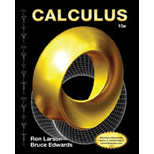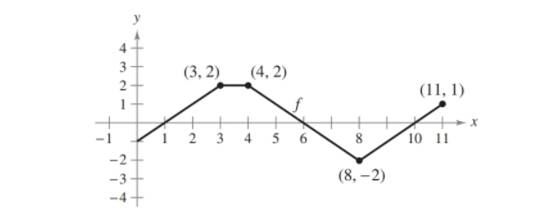
Think About It The graph of f consists of line segments, as shown in the figure. Evaluate each definite

(a)
(c)
(e)
Trending nowThis is a popular solution!

Chapter 4 Solutions
Calculus
Additional Math Textbook Solutions
University Calculus: Early Transcendentals (3rd Edition)
Precalculus: Mathematics for Calculus (Standalone Book)
Single Variable Calculus: Early Transcendentals (2nd Edition) - Standalone book
University Calculus: Early Transcendentals (4th Edition)
Thomas' Calculus: Early Transcendentals (14th Edition)
Precalculus Enhanced with Graphing Utilities (7th Edition)
- Exersice 2.3.16 : Let f and g be the functions defined by f(x) = x - 4 and g(x)= x .Find the functions f + g , ƒ -8 and find their domains.arrow_forwardProficiency #17. [Images and Inverses] Let f : S → T be a function, and let A and B be subsets of T. Prove or give a counterexample to the statement f-1(An B) = f-'(A) n f-'(B).arrow_forwardDetermine the inverse functionarrow_forward
- Easy calculus question, not graded. I will rate and like. Thank you for your work!arrow_forwardLet f (x) = Vx and g(x) - Find the formulas for all four compositions x2 f(f(x)), g(g(x), f(g(x)),g(f(x)) and write their domains. Consider the function f (x) = –(x +2)2 – 2. a. Is the function even, odd, or neither? Explain your answer. b. Find an inverse function f-1(x) for part of the function by restricting the domain.arrow_forwardDERIVE THE F. FUNCTIONS: y-x(x-1) 4x²+3x+2 t.arrow_forward
- a² f a² f For any function f(x, y), dxðy дудхarrow_forwardThe figure is the graph of f', the derivative of a function f. On what open interval(s) is the function of increasing? Select all that apply. 14 I1 13 par I2 □ (0, X₁) (x1, x2) (X2, X3) (x3, x4) O (X4, X5) I5 Iarrow_forwardTutorial Exercise Determine where the function is concave upward and where it is concave downward. (Enter your answer using interval notation. If an answer does not exist, enter DNE.) f(x) = 3x4 - 36x3 + x – 4 Part 1 of 6 We use the ---Select--- Notice that the domain of f is (Enter your answer using interval notation.) First, find the first and second derivatives of f(x) = 3x – 36x3 + x – 4. f'(x) = f"(x) = Submit Skip (you cannot come back)arrow_forward
- Algebra & Trigonometry with Analytic GeometryAlgebraISBN:9781133382119Author:SwokowskiPublisher:Cengage


